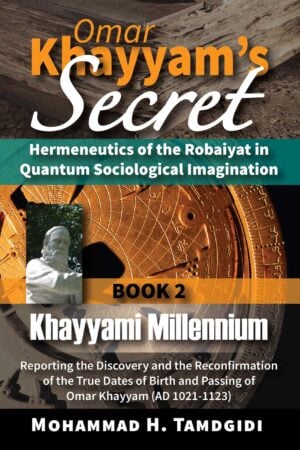Book Section: CHAPTER V — The Foe Who Wrongly Spoke: How Omar Khayyam’s Treatise on the Science of the Universals of Existence Compares to Muhammad Ghazali’s Book “Savior from Error” — by Mohammad H. Tamdgidi
$20.00
This essay, titled “The Foe Who Wrongly Spoke: How Omar Khayyam’s Treatise on the Science of the Universals of Existence Compares to Muhammad Ghazali’s Book ‘Savior from Error’” is the fifth chapter of the book Khayyami Philosophy: The Ontological Structures of the Robaiyat in Omar Khayyam’s Last Written Keepsake Treatise on the Science of the Universals of Existence, which is the fourth volume of the twelve-book series Omar Khayyam’s Secret: Hermeneutics of the Robaiyat in Quantum Sociological Imagination, authored by Mohammad H. Tamdgidi.
Description
Abstract
This essay, titled “The Foe Who Wrongly Spoke: How Omar Khayyam’s Treatise on the Science of the Universals of Existence Compares to Muhammad Ghazali’s Book ‘Savior from Error’” is the fifth chapter of the book Khayyami Philosophy: The Ontological Structures of the Robaiyat in Omar Khayyam’s Last Written Keepsake Treatise on the Science of the Universals of Existence, which is the fourth volume of the twelve-book series Omar Khayyam’s Secret: Hermeneutics of the Robaiyat in Quantum Sociological Imagination, authored by Mohammad H. Tamdgidi.
In her study of Khayyam’s “Treatise on the Science of the Universals of Existence,” Behnaz Hashemipour (1981) reminds us of a seemingly odd coincidence noticed by scholars regarding the similarity of the classification of the four groups of seekers of knowledge of God as found at the end of Khayyam’s treatise to the same classification discussed by the famed contemporary foe of Khayyam, Abu Hamed Muhammad Ghazali, in one of his last works, Al-Munqez men al-Zalal (“Savior from Error”).
Khayyami scholars have over the years speculated about which of the two thinkers originated the classification and its discussion, which offered his views regarding them first, and whether there were any conversations going on between the two explaining their common classificatory language on the topic. While Hashemipour tends to note the similarities of the views expressed by the two thinkers on the common topic, she also acknowledges that the two had many differences in terms of their thinking.
In this chapter, Tamdgidi explores that seemingly odd coincidence. To do so in more depth, he consults the Ghazali’s book directly and revisit in more detail the question of the extent to which the approaches of the two thinkers to the commonly classified religious paths overlap with or differ from one another.
In this effort, Tamdgidi addresses the question of timing of the two writings as well, asking which one was written before the other, since that may shed light on which work was influenced by the other written earlier. He engages more with the substantive dimension of the needed comparative exploration in this chapter, noting that such a consideration of the classified four paths to knowing God can itself also provide us with an additional opportunity to understand how Khayyam and Ghazali approached their differences in the context of the intellectual traditions prevalent in their time.
The author begins with an overview of how Khayyam introduces toward the end of his treatise the defining features of, and differences among, the four groups seeking knowledge of God as prevalent in his time, the theologians, the philosophers, the Ismailis, and the Sufis. Then he offers, while drawing on the introduction of the Persian translation of Ghazali’s book, a biographical chronology of the Ghazali’s life and activities. This is then followed by a detailed summary of the contents of Ghazali’s book “Savior from Error.” Finally comparative evaluation is made of Ghazali’s book in relation to Khayyam’s treatise on the universals of existence.
Tamdgidi’s comparative study of the two writings by Khayyam and Ghazali, leads him to conclude that Khayyam’s treatise was written earlier than Ghazali’s, serving mainly to offer his worldview, at the end of which he introduces the four spiritual paths briefly less as a polemic against those he disagreed with, and more to suggest which path offered a more fruitful method. However, Ghazali’s book is entirely consumed with exposing the wrongs of philosophers, minimally elaborating on his critique of the Ismailis, and seemingly in support of a perspective that exonerates his own theologian background and new Sufi orientation. It seems that Khayyam’s earlier treatise provided an incentive for Ghazali’s rejoinder book, where he anonymously chastises Khayyam as a philosopher, duplicitously fueling the cynical metaphors and criticisms that some theologians and Sufis wrongly hurled at Khayyam in later centuries. Indeed, it was in reference to Ghazali that Khayyam must have written his famous robai starting with the line “The foe wrongly said that a philosopher I am.”
Recommended Citation
Tamdgidi, Mohammad H. 2021. “CHAPTER V —The Foe Who Wrongly Spoke: How Omar Khayyam’s Treatise on the Science of the Universals of Existence Compares to Muhammad Ghazali’s Book “Savior from Error”.” Pp. 207-248 in Omar Khayyam’s Secret: Hermeneutics of the Robaiyat in Quantum Sociological Imagination: Book 4: Khayyami Philosophy: The Ontological Structures of the Robaiyat in Omar Khayyam’s Last Written Keepsake Treatise on the Science of the Universals of Existence. (Human Architecture: Journal of the Sociology of Self-Knowledge: Vol. XVII, 2021. Tayyebeh Series in East-West Research and Translation.) Belmont, MA: Okcir Press.
Where to Purchase Complete Book: The various editions of the volume of which this Book Section is a part can be ordered from the Okcir Store and all major online bookstores worldwide (such as Amazon, Barnes&Noble, Google Play, and others).
Read the Above Publication Online
To read the above publication online, you need to be logged in as an OKCIR Library member with a valid access. In that case just click on the large PDF icon below to access the publication. Make sure you refresh your browser page after logging in.







